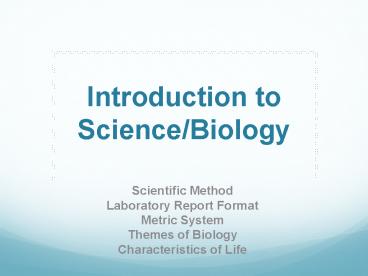Introduction to Science/Biology - PowerPoint PPT Presentation
1 / 33
Title:
Introduction to Science/Biology
Description:
Introduction to Science/Biology Scientific Method Laboratory Report Format Metric System Themes of Biology Characteristics of Life ... – PowerPoint PPT presentation
Number of Views:155
Avg rating:3.0/5.0
Title: Introduction to Science/Biology
1
Introduction to Science/Biology
- Scientific MethodLaboratory Report FormatMetric
SystemThemes of BiologyCharacteristics of Life
2
Scientific Method
3
Steps of the Scientific Method
- 1. Observation ? Problem
- 2. Research (books, journal articles, internet,
etc.) - 3. Hypothesis- a possible explanation to a
problem that can be tested experimentally - 4. Prediction
4
Steps of the Scientific Method
- 5. Experimentation
- A controlled experiment is based on a comparison
of a control group with an experimental group. - The control group and the experimental group are
designed to be identical except for one factor. - This factor is called the independent variable
(manipulated variable). - The dependent variable is the responding variable.
5
Steps of the Scientific Method
- 6. Recording and Analyzing Data
- 7. Conclusion
- 8. Repetition- run the same experiment using the
same materials and methods - 9. Theory- most probable explanation for a set of
data, based on the best available evidence
6
Correlation vs. Causation
- Correlation a relationship in which two or more
things are mutual or complementary - Causation the fact that something causes an
effect, or the action of causing an effect
CORRELATION ? CAUSATION
7
Important Vocabulary
- Controlled Variables variables that must be
controlled or they will have significant effects
on the outcome of the experiment - Level of Treatment the value set for the
independent variable - Method of Replication the manner in which the
experiment is repeated
8
Controlled Experiments
9
Controlled Experiments
- Independent Variable Type of Fertilizer
- Dependent Variables height, weight, leaves,
stems, color, etc. - Controlled Variables sunlight, temperature,
humidity, amount of soil, soil pH, seeds, type
of seeds, pot size, etc.
10
Controlled Experiments
- Level of Treatment 25 g fertilizer/30 days
- Method of Replication Repeat 4 more times using
same materials and methods
11
Laboratory Report Format
12
Laboratory Report Format
- I. Problem
- Usually in the form of a question
- II. Hypothesis
- Usually in the form of an If then statement
- III. Materials
- All materials must be listed (use two or more
columns to save space).
13
Laboratory Report Format
- IV. Procedure
- The procedure is written/typed as a list of
steps. Each step is an individual action. Steps
are never combined. - V. Results - Label with Figure
- Data (entered into tables and charts)
- Appropriate Graphs (line, bar, scatter, etc.)
- Drawings and Diagrams
- Photographs
- Observations
14
Laboratory Report Format
- VI. Conclusions
- Summary of the Laboratory
- Analysis of Data
- Discussion of Error (experimental error,
equipment failure, human error, etc.) - VII. Questions (if applicable)
- Answers to questions are numbered and in complete
sentences.
15
Metric System
16
Metric System Conversions
Move decimal point to right
kilo-
Move decimal point to left
hecta-
deca-
Basic Unit (g, m, L)
deci-
centi-
milli-
17
Example 1
- Convert 25 mg to kg
- 25.0
Move decimal to the left 6 spaces 0.000025 kg
18
Example 2
- Convert 0.5 km to cm
- 0.5
Move decimal to the right 5 spaces 50,000 cm
19
Example 3
- Convert 500 mL to L
- 500.0
Move decimal to the left 3 spaces 0.5 L
20
Themes of Biology
21
Biology
- Biology the science of living organisms and the
interactions among them
22
Seven Major Themes of Biology
- Evolution
- Evolution the theory that species change over
time - Scientists suggest that evolution occurs by a
process called natural selection. - Organisms that have certain inheritable traits
(adaptations) are better able to survive in
specific environments than organisms that lack
those traits.
23
Seven Major Themes of Biology
- Reproduction and Inheritance
- Reproduction asexual (no exchange of genetic
information between organisms) or sexual (genetic
information is exchanged between organisms) - Inheritance the acquisition of traits by
offspring
24
Seven Major Themes of Biology
- Development
- Development the process by which an organism
grows - Unicellular vs. Multicellular Development
25
Seven Major Themes of Biology
- Structure and Function
- Morphology the internal and external appearance
of an organism - Anatomy Internal Morphology
- STRUCTURE DETERMINES FUNCTION
26
Seven Major Themes of Biology
- Energy Relationships
- All organisms use energy
- Autotrophs vs. Heterotrophs
27
Seven Major Themes of Biology
- Ecology
- Ecology the study of the relationship between
organisms and their environments - Interdependence
28
Seven Major Themes of Biology
- Science and Society
- Knowledge from biological science can be applied
to specific problems in society to improve human
life. - How biological knowledge should be used involves
decisions based on ethics (bioethics)
29
Characteristics of Life
30
Seven Characteristics of Life
- Cells all living things are composed of cells
- Organization all organisms are organized at both
molecular and cellular levels - atoms ? molecules ? organelles ? cells ? tissues
? organs ? organ systems ? organisms
31
Seven Characteristics of Life
- Metabolism all organisms use energy for growth
and maintenance - Response to the Environment a response is a
reaction to a stimulus - Growth all living things grow, growth occurs
through cell division and cell enlargement
32
Seven Characteristics of Life
- Reproduction all organisms have the ability to
reproduce, reproduction is necessary for the
continuity of life - Adaptation organisms have adaptations that give
them an advantage in an environment
33
(No Transcript)































